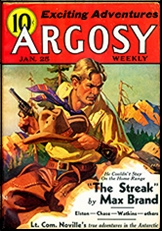Fri 31 Jan 2020
Stories I’m Reading: ALLEN K. YOUNG “Reflection on Murder.”
Posted by Steve under Authors , Bibliographies, Lists & Checklists , Characters , Stories I'm Reading[2] Comments
ALLEN K. YOUNG “Reflection on Murder.” Short story. Professor Posenby #2. First published in Ellery Queen’s Mystery Magazine, October 1968. Presumably never reprinted.
The tenth rule of Ronald Knox’s Ten Commandments of Detective Fiction says that “twin brothers, and doubles generally, must not appear unless we have been duly prepared for them.” This second of several stories Alan K. Young wrote about retired poetry and code expert Professor Ponsby (no first name known) takes this rule head on and makes an excellent story out of it.
It doesn’t in any way break the rule, since the fact that Tom and Barnaby Varden are twins is stated up front with no denying it. There is also no denying that one of them murdered their uncle, but which one? Almost no one can tell them apart, so eye witnesses to the fact that one was seen leaving the house at the time of murder are of no value.
What’s more, the other brother was seen at a boxing match the next town over at the time of the murder, gives one of the two an unshakeable alibi. But which one was which?
Totally sure that no jury would ever convict either one “beyond a shadow of a doubt,” they boastfully send the following poem to the harried police chief, who comes to Ponsby with it. I hope you can read it:
I believe I have read another story with exactly the premise, but without the poem, and yet, if so, I do not remember where I read it or who wrote it. You may be able to figure it out — all the clues are there — but I am chagrined to say I didn’t. This is a puzzle story only, with only a cursory attempt at characterization, but as such it’s exceedingly well done. It’s like admiring a solidly constructed crossword puzzle at the end of the week in the New York Times. I enjoyed it immensely.
It probably won’t ever happen, but Young wrote enough Ponsby stories to put together a very decent collection. I’d buy it!
NOTE: Alan K. Young’s papers regarding his short story writing are stored at Columbia University. A short desription of the collection says that the author “is a former junior-college English instructor, with a B. A. in English from Harvard and an M. A. in the same subject from the University of California.”
The Professor Ponsonby series —
Letter from Mindoro (ss) Ellery Queen’s Mystery Magazine Mar 1968
Reflection on Murder (ss) Ellery Queen’s Mystery Magazine Oct 1968
The Secret of the Golden Tile (ss) Ellery Queen’s Mystery Magazine Jun 1969
Ponsonby and the Shakespeare Sonnet (ss) Ellery Queen’s Mystery Magazine Oct 1969
Ponsonby and the Dying Words (ss) Ellery Queen’s Mystery Magazine Aug 1970
Ponsonby and the Classic Cipher (ss) Ellery Queen’s Mystery Magazine Dec 1971
Child’s Play (vi) Ellery Queen’s Mystery Magazine Jan 1972
Ponsonby and the Ransom Note (ss) Ellery Queen’s Mystery Magazine Jun 1972
To See Death Coming (ss) Ellery Queen’s Mystery Magazine Apr 1973
Truth Will Out (ss) Ellery Queen’s Mystery Magazine Jun 1974
Incident on a Bus (ss) Ellery Queen’s Mystery Magazine Feb 1975
—
PostScript: Since most you are not likely to ever read this story, I will give you a big hint as to the solution in Comment 1. Don’t read it until you’ve either given up or you want to know if the answer you’ve come up with is correct or not.
Added later: A full explanation is given in Comment #2.
